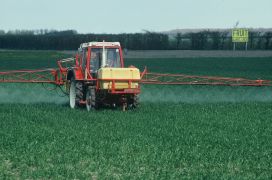Differences
This shows you the differences between two versions of the page.
| Both sides previous revisionPrevious revisionNext revision | Previous revision | ||
| capri:concept:referencerun [2011/04/13 16:16] – gocht | capri:concept:referencerun [2022/11/07 10:23] (current) – external edit 127.0.0.1 | ||
|---|---|---|---|
| Line 1: | Line 1: | ||
| - | <<!-- Start Inhalt --> | + | p |
| - | <div class=rightwindow> | + | |
| - | + | ||
| - | < | + | |
| - | < | + | |
| - | <TABLE padding=" | + | |
| - | < | + | |
| - | + | ||
| - | with CAPRI. It reflects the most probable development in agricultural markets | + | |
| - | + | ||
| - | from global to regional scale for 8-10 year time horizon, at the current legislation. | + | |
| - | + | ||
| - | It integrates agricultural market projections from other insitutions as FAPRI, FAO and DG-AGRI. | + | |
| - | + | ||
| - | Unique for CAPRI are regional resolution below the national level for EU27 at the level of | + | |
| - | + | ||
| - | NUTS 2 regions, and the Bayesian methodology applied.</ | + | |
| - | + | ||
| - | + | ||
| - | + | ||
| - | < | + | |
| - | + | ||
| - | are calibrated to results of the reference run.</ | + | |
| - | + | ||
| - | + | ||
| - | + | ||
| - | + | ||
| - | + | ||
| - | + | ||
| - | + | ||
| - | + | ||
| - | + | ||
| - | + | ||
| - | + | ||
| - | <P>In opposite to many other reference run approaches, CAPRI employs a Bayesian estimation | + | |
| - | + | ||
| - | framework to define a mutually consistent set of projection values for activity levels, | + | |
| - | + | ||
| - | yields, production, feed and processing demand, human consumption, | + | |
| - | + | ||
| - | all major equations from the supply and market modules are defined as in an optimization | + | |
| - | + | ||
| - | framework which maximizes the joint posterior density for given a priori distribution | + | |
| - | + | ||
| - | of the different elements.</ | + | |
| - | + | ||
| - | + | ||
| - | + | ||
| - | </ | + | |
| - | + | ||
| - | < | + | |
| - | + | ||
| - | </ | + | |
| - | + | ||
| - | </ | + | |
| - | + | ||
| - | </ | + | |
| - | + | ||
| - | + | ||
| - | + | ||
| - | < | + | |
| - | + | ||
| - | + | ||
| - | + | ||
| - | <TABLE padding=" | + | |
| - | + | ||
| - | < | + | |
| - | + | ||
| - | </ | + | |
| - | + | ||
| - | < | + | |
| - | + | ||
| - | + | ||
| - | + | ||
| - | < | + | |
| - | + | ||
| - | long terms are projected. Using "no change" | + | |
| - | + | ||
| - | between the base year value and the trend estimate is calculated, using R squared | + | |
| - | + | ||
| - | as weight for the trend estimate.</ | + | |
| - | + | ||
| - | < | + | |
| - | + | ||
| - | by the relative effect of implementing already decided upon changes in agricultural policies in the base | + | |
| - | + | ||
| - | year - so-called " | + | |
| - | + | ||
| - | resulting estimates along with the estimation error of the trend deliver a priori distributions | + | |
| - | + | ||
| - | for all items in the estimation framework.</ | + | |
| - | + | ||
| - | + | ||
| - | + | ||
| - | + | ||
| - | + | ||
| - | + | ||
| - | + | ||
| - | <P>In a first step, the estimation is solved for these trend support, indepedently for each country. Afterwards, results are aggregated to | + | |
| - | + | ||
| - | EU. The projections of other instutions are then added, and replace where available the supports based on trends. | + | |
| - | + | ||
| - | If the projections are only reporting values for the EU and not for individual countries, | + | |
| - | + | ||
| - | the country results from the first steps are used to distributed the EU estimate. The standard errors for the there projections, | + | |
| - | + | ||
| - | especially for those provided by DG-AGRI, is set rather narrow, ensuring that the values are recovered as long as they do not violate | + | |
| - | + | ||
| - | the consistency restrictions.</ | + | |
| - | + | ||
| - | + | ||
| - | + | ||
| - | < | + | |
| - | + | ||
| - | down in a similar framework to NUTS 2 level, and from there to farm type groups.</ | + | |
| - | + | ||
| - | + | ||
| - | + | ||
| - | </ | + | |
| - | + | ||
| - | </ | + | |
| - | + | ||
| - | </ | + | |
| - | + | ||
| - | + | ||
| - | + | ||
| - | < | + | |
| - | + | ||
| - | < | + | |
| - | + | ||
| - | | + | |
| - | + | ||
| - | and products, and over countries to EU15, EU10 etc. are defined and reported in tables accessible via the Graphical user interface. | + | |
| - | + | ||
| - | Those tables compare systematically the different inputs (trend estimate, policy shift, estimation results from the different steps).</ | + | |
| - | + | ||
| - | + | ||
| - | + | ||
| - | < | + | |
| - | + | ||
| - | run exercise for the OECD/FAO AGLINK-COSIMA model with an estimated input of 20 person months and the CAPRI reference run | + | |
| - | + | ||
| - | with an estimated inputs of about 2 person months is reported by <A HREF=http:// | + | |
| - | + | ||
| - | + | ||
| - | + | ||
| - | < | + | |
| - | + | ||
| - | <P class=" | + | |
| - | + | ||
| - | < | + | |
| - | + | ||
| - | </ | + | |
| - | + | ||
| - | </ | + | |
| - | + | ||
| - | + | ||
| - | </ | + | |
Except where otherwise noted, content on this wiki is licensed under the following license: CC Attribution-Share Alike 4.0 International


